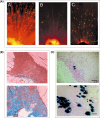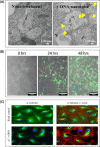Multifunctional DNA-Collagen Biomaterials: Developmental Advances and Biomedical Applications
- PMID: 39869382
- PMCID: PMC11897955
- DOI: 10.1021/acsbiomaterials.4c01475
Multifunctional DNA-Collagen Biomaterials: Developmental Advances and Biomedical Applications
Abstract
The complexation of nucleic acids and collagen forms a platform biomaterial greater than the sum of its parts. This union of biomacromolecules merges the extracellular matrix functionality of collagen with the designable bioactivity of nucleic acids, enabling advances in regenerative medicine, tissue engineering, gene delivery, and targeted therapy. This review traces the historical foundations and critical applications of DNA-collagen complexes and highlights their capabilities, demonstrating them as biocompatible, bioactive, and tunable platform materials. These complexes form structures across length scales, including nanoparticles, microfibers, and hydrogels, a process controlled by the relative amount of each component and the type of nucleic acid and collagen. The broad distribution of different types of collagen within the body contributes to the extensive biological relevance of DNA-collagen complexes. Functional nucleic acids can form these complexes, such as siRNA, antisense oligonucleotides, DNA origami nanostructures, and, in particular, single-stranded DNA aptamers, often distinguished by their rapid self-assembly at room temperature and formation without external stimuli and modifications. The simple and seamless integration of nucleic acids within collagenous matrices enhances biomimicry and targeted bioactivity, and provides stability against enzymatic degradation, positioning DNA-collagen complexes as an advanced biomaterial system for many applications including angiogenesis, bone tissue regeneration, wound healing, and more.
Keywords: DNA aptamers; DNA nanotechnology; bioactive hydrogel; collagen; nucleic acid-collagen complexes.
Conflict of interest statement
The authors declare no competing financial interest.
Figures





Similar articles
-
Mineralized DNA-collagen complex-based biomaterials for bone tissue engineering.Int J Biol Macromol. 2020 Oct 15;161:1127-1139. doi: 10.1016/j.ijbiomac.2020.06.126. Epub 2020 Jun 16. Int J Biol Macromol. 2020. PMID: 32561285 Free PMC article.
-
Conductive, injectable, and self-healing collagen-hyaluronic acid hydrogels loaded with bacterial cellulose and gold nanoparticles for heart tissue engineering.Int J Biol Macromol. 2024 Nov;280(Pt 2):135749. doi: 10.1016/j.ijbiomac.2024.135749. Epub 2024 Sep 18. Int J Biol Macromol. 2024. PMID: 39299426
-
Biopolymeric hydrogels - nanostructured TiO2 hybrid materials as potential injectable scaffolds for bone regeneration.Colloids Surf B Biointerfaces. 2016 Dec 1;148:607-614. doi: 10.1016/j.colsurfb.2016.09.031. Epub 2016 Sep 22. Colloids Surf B Biointerfaces. 2016. PMID: 27694050
-
Smart and Functionalized Development of Nucleic Acid-Based Hydrogels: Assembly Strategies, Recent Advances, and Challenges.Adv Sci (Weinh). 2021 May 7;8(14):2100216. doi: 10.1002/advs.202100216. eCollection 2021 Jul. Adv Sci (Weinh). 2021. PMID: 34306976 Free PMC article. Review.
-
The Collagen Suprafamily: From Biosynthesis to Advanced Biomaterial Development.Adv Mater. 2019 Jan;31(1):e1801651. doi: 10.1002/adma.201801651. Epub 2018 Aug 20. Adv Mater. 2019. PMID: 30126066 Review.
Cited by
-
Reshaping transplantation with AI, emerging technologies and xenotransplantation.Nat Med. 2025 Jul;31(7):2161-2173. doi: 10.1038/s41591-025-03801-9. Epub 2025 Jul 14. Nat Med. 2025. PMID: 40659768 Review.
References
-
- Madduma-Bandarage U. S. K.; Madihally S. V. Synthetic Hydrogels: Synthesis, Novel Trends, and Applications. J. Appl. Polym. Sci. 2021, 138 (19), 5037610.1002/app.50376. - DOI
Publication types
MeSH terms
Substances
Grants and funding
LinkOut - more resources
Full Text Sources
